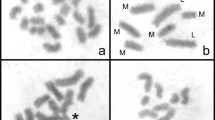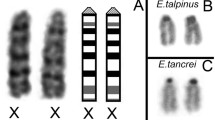Summary
Tribolium confusum differs from T. castaneum in having a neo-XY sex-determining mechanism. The neo-Y is negatively heteropycnotic at metaphase I. At pachytene all bivalents have positively heteropycnotic blocks consisting of approximately spherical half-blocks separated by the centromere. The half-blocks throughout the complement measure about 0,6μ. Three bivalents, including the XY, have euchromatic segments attached to only one half-block; the remaining six have them attached to each. The bivalents are individually recognisable, and the X is associated with the nucleolus through its purely heterochromatic arm. p Five distinct spiralization coefficients are concerned in the condensation of the XY pair between pachytene and metaphase. Only two are operative in autosomal contraction.
The following conclusions have been reached:
-
1)
Differential reactivity in Tribolium is primarily a matter of relative density of spiralization.
-
2)
The centric blocks, being heteropycnotic in both sexes, differ from the heterochromatin of the relic X. which is heteropycnotic in the male only.
-
3)
The capacity of heterochromatin to undergo crossing over is dependent on its specific cycle of spiralization coinciding with that of the euchromatin at zygotene and pachytene. Chiasma formation is therefore totally precluded from the centric blocks. Distal localization of chiasmata is genotypically determined.
-
4)
The centric half-blocks in this way constitute a minimum value for Matheb's differential distance, which, however, is independent of chromosome length.
-
5)
A certain minimum length of euchromatin is required to accommodate chiasmata.
-
6)
That the paired arms of X and Y are indistinguishable at pachytene is incompatible with the concept that the internal differentiation of heterochromatin is less than that of euchromatin.
-
7)
Views concerning the location of polygenes are similarly open to question.
-
8)
The occurrence of a much smaller neo-Y in T. destructor and its failure to show heteropycnosis suggests that the neo-Y in confusum is in large part inert.
-
9)
The precise conjugation of the X and Y pairing arms proves them to be homologous and proves, moreover, thatheterochromatin is derivable from euchromatin.
-
10)
In agreement with Muller, the negative heteropycnosis and inertness of the Y are considered a response to its permanent isolation in the male sex.
-
11)
If the centric blocks are also inert, their retention may be obligatory in so far as their loss would lower the chiasma frequency, already close to a minimum value, and hence the recombination index.
Similar content being viewed by others
References
Asana, J. J., S. Makino, and H. Niiyama: A chromosome survey of some Indian insects. IV. On the sex chromosomes of some species of beetles (Coleoptera). Cytologia 12, 187–205 (1942).
Babcock, E. B.: Cytogenetics and speciation in Crepis. Adv. Genetics 1, 69–93 (1947).
- Barrigozzi, C.: A general survey of heterochromatin. Portug. Acta Biol., Ser. A, R. B. Goldschmidt Vol. 593–620 (1950).
Barton, D. W.: Localized chiasmata in the differentiated chromosomes of the tomato. Genetics 36, 374–381 (1951).
Bridges, P. N.: A new map of the salivary gland II L chromosome of Drosophila melanogaster. J. Hered. 33, 403–408 (1942).
Brown, S. W.: The structure and meiotic behaviour of the differentiated chromosomes of tomato. Genetics 34, 437–461 (1949).
Callan, H. G.: Heterochromatin in Triton. Proc. Roy. Soc. Lond. B 130, 324–335 (1942).
—: Ribose nucleic acid in the Drosophila egg. Nature (Lond.) 161, 440 (1948).
Caspersson, T.: Über die Rolle der Desoxyribosenukleinsäure bei der Zellteilung. Chromosoma 1, 147–156 (1939).
—: The relations between nucleic acid and protein synthesis. Symp. Soc. Exper. Biol. 1, 127–151 (1947).
Caspersson, T., E. Hammarsten, and H. Hammarsten: Interactions of proteins and nucleic acid. Trans. Faraday Soc. 31, 367–389 (1935).
Caspersson, T., and J. Schultz: Nucleic acid metabolism of the chromosomes in relation to gene reproduction. Nature (Lond.) 142, 294–295 (1938).
Darlington, C. D.: Recent Advances in Cytology. 2. Ed. London: Churchill 1937.
—: Chromosome chemistry and gene action. Nature (Lond.) 149, 66–69 (1942).
Darlington, C. D., and L. La Cour: Differential reactivity of the chromosomes. Ann. of Bot., N. s. 2, 615–625 (1938).
—: Nucleic acid starvation of chromosomes in Trillium. J. Genet. 40, 185–213 (1940).
—: The detection of inert genes. J. Hered. 32, 115–121 (1941).
Darlington, C. D., and M. B. Upcott: The measurement of packing and contraction in chromosomes. Chromosoma 1, 23–32 (1939).
—: The activity of inert genes in Zea mays. J. Genet. 41, 275–296 (1941).
Gottschalk, W.: Untersuchungen am Pachytän normaler und röntgenbestrahlter Pollenmutterzellen von Solanum lycopersicum. Chromosoma 4, 298–341 (1951).
Guénin, H. A.: Chromosomes et hétérochromosomes de ténébrionidés. Genetica ('s-Gravenhage) 25, 157–182 (1950).
Hackman, W.: Chromosomenstudien an Araneen mit besonderer Berücksichtigung der Geschlechtschromosomen. Acta zool. fenn. 54, 1–101 (1948).
Heitz, E.: Heterochromatin, Chromocentren, Chromomeren. Ber. dtsch. bot. Ges. 47, 274–284 (1929).
—: Die Herkunft der Chromozentren. Planta (Berl.) 18, 571–635 (1932).
—: Die somatische Heteropyknose bei Drosophila melanogaster und ihre genetische Bedeutung. Z. Zellforschg 20, 237–287 (1933).
—: Chromosomenstruktur und Gene. Z. I. A. V. 70, 402–447 (1935).
Hinton, H. E.: A synopsis of the genus Tribolium Macleay, with some remarks on the evolution of its species-groups (Coleoptera, Tenebrionidae). Bull. Entomol. Res. 39, 13–56 (1948).
King, R. L.: The neo-Y chromosome in Hypochlora alba and Mermiria intertexta (Orthoptera: Acrididae). J. of Morph. 87, 227–237 (1950).
Koller, P. C.: The genetical and mechanical properties of the sex-chromosomes. IV. The golden hamster. J. Genet. 36, 177–195 (1938).
Koller, P. C., and C. D. Darlington: The genetical and mechanical properties of the sex-chromosomes. I. Rattus norvegicus ♂. J. Genet. 29, 159–173 (1934).
La Cour, L. F.: Heterochromatin and the organization of nucleoli in plants. Heredity 5, 37–50 (1951).
Makino, S.: Studies on the murine chromosomes. V. A study of the chromosomes in Apodemus, especially with reference to the sex chromosomes in meiosis. J. of Morph. 88, 93–126 (1951).
- Mather, K.: The determination of position in crossing over. II. The chromosome length-chiasma frequency relation. Cytologia, Fujii Jub. Vol., 514–526 (1937).
—: The determination of position in crossing over. III. The evidence of metaphase chiasmata. J. Genet. 39, 205–223 (1940).
—: Polygenic balance and the canalization of development. Nature (Lond.) 151, 68–71 (1943).
—: The genetical activity of heterochromatin. Proc. Roy. Soc. Lond. B 132, 308–332 (1944).
Matthey, R.: Encore les hétérochromosomes des Apodemus. Arch. Klaus-Stiftg 22, 85–92 (1947).
McClintock, B.: The association of non-homologous parts of chromosomes in the mid-prophase of meiosis of Zea mays. Z. Zellforschg 19, 191–232 (1933).
McNabb, J. W.: A study of the chromosomes in meiosis, fertilization and cleavage in the grasshopper egg (Orthoptera). J. of Morph. 45, 47–93 (1928).
Muller, H. J.: Genetic variability, twin hybrids, and constant hybrids in a case of balanced lethal factors. Genetics 3, 422–499 (1918).
Muller, H. J., and T. S. Painter: The differentiation of the sex chromosomes of Drosophila into genetically active and inert regions. Z. I. A. V. 62, 316–365 (1932).
Östergren, G.: Heterochromatic B-chromosomes in Anthoxanthum. Hereditas (Lund) 33, 261–296 (1947).
—: Isopycnosis and isopycnotic, two new terms for use in chromosome studies. Hereditas (Lund) 36, 511–513 (1950).
Pontecorvo, G.: Meiosis in the striped hamster (Cricetulus griseus Milne Edw.) and the problem of heterochromatin in mammalian sex chromosomes. Proc. Roy. Soc. Edinburgh B 62, 32–42 (1943).
—: Structure of heterochromatin. Nature (Lond.) 153, 365–367 (1944).
Schrader, F., and C. Leuchtenberger: A cytochemical analysis of the functional interrelationships of various cell structures in Arvelius albopunctatus (de Geer). Exper. Cell Res. 1, 421–452 (1950).
Smith, S. G.: Evolutionary changes in the sex chromosomes of Coleoptera. I. Wood borers of the genus Agrilus. Evolution 3, 344–357 (1949).
—: The cyto-taxonomy of Coleoptera. Canad. Entom. 82, 58–68 (1950)
- Evolutionary changes in the sex chromosomes of Coleoptera, II. Tenebrionidae. Genetica ('s-Gravenhage) 1951.
- The cytology of some tenebrionoid beetles (Coleoptera). J. of Morph. 1952a.
- The cytology of Sitophilus (Calandra) oryzae, (L.), S. granarius (L.), and some other Rhynchophora (Coleoptera). Cytologia 1952b.
- Additions to and an amendment of Makino's list of chromosome numbers in the Coleoptera. Heredity (in MS.) 1952c.
Stevens, N. M.: The chromosomes of Diabrotica vittata, Diabrotica soror and Diabrotica 12-punctata: A contribution to the literature on heterochromosomes and sex determination. J. Exper. Zool. 5, 453–475 (1908).
Tobgy, H. A.: A cytological study of Crepis fuliginosa, C. neglecta, and their F1 hybrid, and its bearing on the mechanism of phylogenetic-reduction in chromosome number. J. Genet. 45, 67–111 (1943).
White, M. J. D.: Tetraploid spermatocytes in a locust, Schistocerca gregaria. Cytologia 5, 135–139 (1933).
—: The heteropycnosis of sex chromosomes and its interpretation in terms of spiral structure. J. Genet. 40, 67–82 (1940).
—: Animal Cytology and Evolution. Cambridge: University Press 1945.
—: Cytological studies of gall midges (Cecidomyidae). Univ. Texas Publ. 5007, 1–80 (1950).
—: Cytology and Cell Physiology. Edited by G. H. Bourne, London: Oxford University Press 1951.
Wilson, G. B., and E. R. Boothroyd: Temperature induced differential contraction in the somatic chromosomes of Trillium erectum L. Canad. J. Res. C 22, 105–119 (1944).
Yosida, T.: Chromosome studies in the Coleoptera. I. A study of the chromosomes in ten species of Coccinellidae and Chrysomelidae. Jap. J. of Genet. 20, 107–115 (1944).
—: Chromosome studies in the Coleoptera. IV. Comparison of the chromosomes in five species of the Scarabaeidae. Trans. Sapporo Nat. Hist. Soc. 18, 43–48 (1949a).
—: The structure and formative elements of the sex chromosomes of Luperodes praeustus Motsch., with a consideration of their evolution. Jap. J. of Genet. 24, 156–162 (1949b).
Author information
Authors and Affiliations
Additional information
Contribution No. 27, Division of Forest Biology, Science Service, Department of Agriculture, Ottawa, Canada.
Cytogeneticist, Forest Insect Laboratory, Sault Ste. Marie, Ontario.
Rights and permissions
About this article
Cite this article
Smith, S.G. The evolution of heterochromatin in the genus tribolium (Tenebrionidae: Coleoptera). Chromosoma 4, 585–610 (1950). https://doi.org/10.1007/BF00325793
Received:
Issue Date:
DOI: https://doi.org/10.1007/BF00325793




